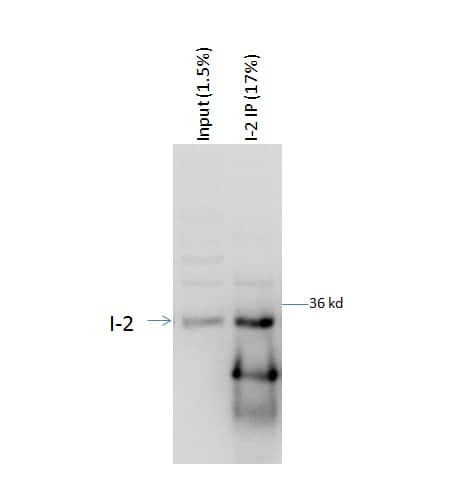| Reactivity | Hu, Mu, RtSpecies Glossary |
| Applications | WB, Simple Western |
| Clonality | Polyclonal |
| Host | Goat |
| Conjugate | Unconjugated |
| Concentration | LYOPH |
| Immunogen | E. coli-derived recombinant human PP1 Inhibitor-2 Met1-Ser205 Accession # P41236 |
| Specificity | Detects human, mouse and rat PP1 Inhibitor-2 in Western blots. In Western blots, no cross-reactivity with recombinant human PP1 Inhibitor-1 or DARPP-32 is observed. |
| Source | N/A |
| Isotype | IgG |
| Clonality | Polyclonal |
| Host | Goat |
| Gene | PPP1R2 |
| Purity Statement | Antigen Affinity-purified |
| Innovator's Reward | Test in a species/application not listed above to receive a full credit towards a future purchase. |
| Dilutions |
|
|
| Reviewed Applications |
|
|
| Publications |
|
| Storage | Use a manual defrost freezer and avoid repeated freeze-thaw cycles.
|
| Buffer | Lyophilized from a 0.2 μm filtered solution in PBS with Trehalose. *Small pack size (SP) is supplied either lyophilized or as a 0.2 µm filtered solution in PBS. |
| Preservative | No Preservative |
| Concentration | LYOPH |
| Reconstitution Instructions | Reconstitute at 0.2 mg/mL in sterile PBS. |
Protein Phosphatase 1 Inhibitor-2 (PP1 Inhibitor-2), also called PP1 regulatory subunit 2 (PP1R2), I2, and IPP2, binds to PP1 through an RVxF consensus sequence. The complex inactivates PP1, preventing it from dephosphorylating substrates such as glycogen phosphorylase. Unlike PP1 Inhibitor-1, the binding of PP1 Inhibitor-2 is Protein Kinase A phosphorylation-independent. Dissociation of the PP1 Inhibitor-2 complex is enhanced by phosphorylation at T72 by GSK3, ERK, or CDK. Overexpression of PP1 Inhibitor-2 in mouse heart improves cardiac function without changing organ size.
| Images | Ratings | Applications | Species | Date | Details | ||||||||
|---|---|---|---|---|---|---|---|---|---|---|---|---|---|

Enlarge |
reviewed by:
Verified Customer |
WB | Rat | 01/25/2016 |
Summary
|
Secondary Antibodies |
Isotype Controls |
The concentration calculator allows you to quickly calculate the volume, mass or concentration of your vial. Simply enter your mass, volume, or concentration values for your reagent and the calculator will determine the rest.